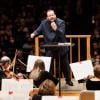
Redwood Symphony’s much-anticipated performance of Dmitri Shostakovich’s Symphony No. 4, originally scheduled for the pandemic year of 2020, finally took place on Saturday, Nov. 23, at Cañada College. Anyone familiar with Redwood Symphony’s particular strengths would have been looking forward to the concert, which, as expected, was a dazzler.
Shostakovich’s symphonies are often compared with those of Gustav Mahler — they’re long, full of conflicting emotions, and laced with grotesqueries. Redwood Symphony and its music director, Eric Kujawsky, are known for their excellent and perceptive performances of Mahler, so they would do well with Shostakovich, especially the Fourth, which is by far the most Mahlerian symphony the Soviet composer ever wrote, even incorporating some near-quotations.
Other mature Shostakovich symphonies integrate their contrasts in a coherent and well-shaped structure, but the Fourth juxtaposes searing climaxes, jagged anxiety, quirky jokes, and pregnant hushes in an unexpected manner that can be baffling. The Fourth is always out to surprise listeners.

The piece has a strange history. Written in 1935 and 1936, it was the culmination of Shostakovich’s early modernist period, when the Soviet Union still saw itself as a revolutionary regime and encouraged its artists to cut loose. But around that same time, the commissars blew the whistle and ordered a pivot to “audience-friendly” socialist realism. After a nasty editorial in Pravda, the official Communist Party newspaper, denouncing Shostakovich’s latest opera, the composer withdrew the yet-unperformed Fourth Symphony from rehearsal. It wasn’t played until 25 years later, during the Khrushchev Thaw. By then, Shostakovich’s style had altered considerably, and the Fourth only puzzled listeners. It hasn’t been heard much since.
The symphony begins with three shrill crashes and continues with a brutal stomping theme. This dies down after a while, but only briefly. What follows is an hourlong series of sudden juxtapositions. Saturday’s performance offered little new insight into the Fourth’s structure, but it moved along with avidity. The entire work was snappy and exciting. Whatever was going on at any moment, it was clear that Kujawsky believed in the music wholeheartedly, and he communicated this to his performers.
Throughout, the huge orchestra sounded crisp and well defined, powerful and clear, even when bursting out at the sudden climaxes, which are among the loudest ever written in classical music. The quieter passages often achieved an intriguing creepiness, relaxing the tension without sacrificing the tempo.
The third and final movement was particularly excellent. The ramping up from the opening Largo to the Allegro was powerfully evocative, more potent than in any recording I’ve heard. So was the final climax, which can sometimes sound curiously empty; here it was tight, firm, and powerful. The desolate coda that follows was given thrust and drive by an emphasis on the chugging background rhythm in the double basses and harp.
If some of the more wandering parts of the symphony tended to wander too much, the innumerable lengthy solos — one for concertmaster Danny Coward, the others for winds and brass and even percussion — were fully effective and often impressively on point. Principal bassoon Theo Clarke had many solos, all well executed.

Saturday’s concert began with two small-scale introductory pieces. Felix Mendelssohn’s bold and outgoing Overture in C Major, Op. 24, is for wind instruments, though a few percussion interjections increase the resemblance to a marching band. The piece was played in full-bodied style under the direction of Assistant Conductor Kyle Baldwin.
Mozart’s Bassoon Concerto in B-flat Major, K. 191, is brief, light, and unpretentious. With Kujawsky conducting, Yueh Chou played the solo part with skill and ease, producing a smooth and gentle sound that made the accompanying orchestra, small as it was, sound brash, even bumptious. The alternately wild and melodic solo passages were an ideal illustration of what a bassoon can do in kind and sympathetic hands.
There was even more going on in the bassoon section Saturday. Two hours before the concert, the contrabassoonist for the Shostakovich had to cancel for medical reasons, so second bassoon Sam Troxell moved over to that part, and Chou stepped in on second at Kujawsky’s request. Both players were sight-reading with no rehearsal, and Chou had never even heard the work before. It all came out amazingly well, just more of the good fortune that blessed this performance recovered from 2020.




